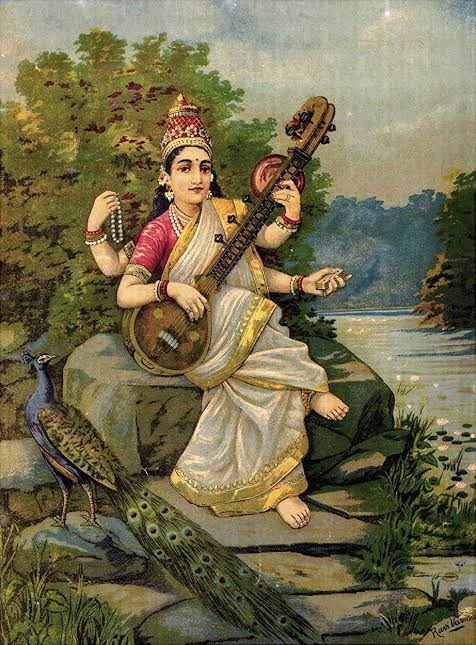Reading Time: 6 minutes
Saraswati is seen as Adi Shakti, symbolising the ultimate truth. She is considered the Guru, the knowledge giver, elucidates Monika in the exclusive Special Feature for Different Truths.

Saraswati, a Hindu goddess of wisdom, aesthetics and learning, is revered as Vedmata (Mother of Vedas) and the Creator of Sanskrit (Devbhasha), an ancient language – one of the oldest. She is also worshipped as Sharda, Vagdevi / Vageswari and Bharati (Goddess of speech, articulating eloquence). She is also known as Shatarupa (Female form of Brahma / creation), personifying enticing yet transitory material reality.
Saraswati evinces speech (Vakh/Vak), thenceforth enlighten the world of form and name, existing as material, abstract or obscure; present, past, or future; celestial or terrestrial; known, unknown, or to be known. The Goddess of learning, reasoning (Jyoti Swarup), and the light within, Saraswati manifests as the most benevolent goddess. She ends Avidya (deep-rooted ignorance) or darkness in any form. She effectuates creative faculty and therefore is seen as the fountainhead of art, science, literature, music, and creativity.
The Self-essence
The literal meaning of Saraswati is “Self-essence”, as derived out of Sanskrit words “Swa”, meaning ‘self’ and “Sara”, meaning ‘essence’. Saraswati is also seen as “flowing discerningly” – ‘Saras’ meaning ‘flowing’ and ‘wati’ meaning ‘she who has’ symbolic of her stature as one of the revered rivers, flowing as the stream of consciousness. Saraswati called Sarsuti, just like the Ganga River (personified as deities), flows from the Himalayas and is considered a sacred source of purification.
She is viewed as Brahmani and Adi Shakti.
The numerous regional manifestations, faiths, forms, and avatars of goddess Saraswati all over India have led to diverse traditions and ways of worshipping. Saraswati is believed to have many forms. She is viewed as Brahmani and Adi Shakti. She is symbolised as the ultimate truth and is considered Guru, the knowledge giver. Also, Sharada is the form of Saraswati as a daughter of Marichi, in which she bestows poetic and musical enlightenment.
Mostly Saraswati Puja is held on Basant Panchami, the first day of the Spring, and worshippers wear yellow, which is associated with wisdom and prosperity. Believers seek blessings on their pens, books, and musical instruments. Kids are taught to write for the first time during the festival, and even ancestors are revered. During Navratri, the pan-Indian festival devoted to three feminine energies, Saraswati is worshipped along with other major goddesses.
Nine Forms of Durga
Saraswati, as Mahasaraswati, is considered part of the nine forms of Durga, revered as powerful and all-consuming. Eventually, all the characteristics denote one Goddess, which helps maintain the world’s balance.
She is mainly seen without gems and jewellery, denoting no concern for the base and materialistic things.
Saraswati is usually depicted as a poised and graceful goddess draped in a white sari (symbolising purity) with a light blue border. She is mainly seen without gems and jewellery, denoting no concern for the base and materialistic things. Mounted on a white swan (indicating pure knowledge) as her vehicle (vahana), a crescent adorns her forehead (symbolising growing wisdom). She is seen seated on a lotus flower (symbolising the need to remain untouched by the negative influences).
The Goddess of learning is sometimes seen accompanied by a peacock, her herald. As with many Hindu deities, Saraswati is often depicted with four arms, symbolising a variety of concepts: Her immanence and transcendence. Anterior ones depict the Goddess’ activity in the material realm, while the posterior arms activity is in the spiritual realm. The four arms (elements of inner life) symbolise Mana (mind), Buddhi (intellect), Chitta (consciousness) and Ahankara (ego).
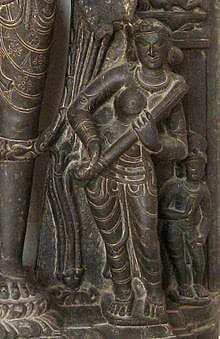
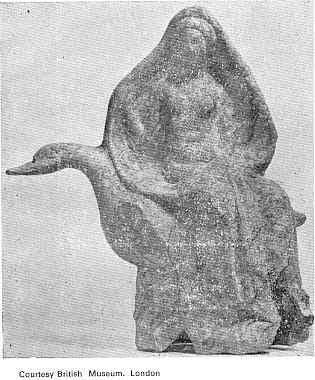
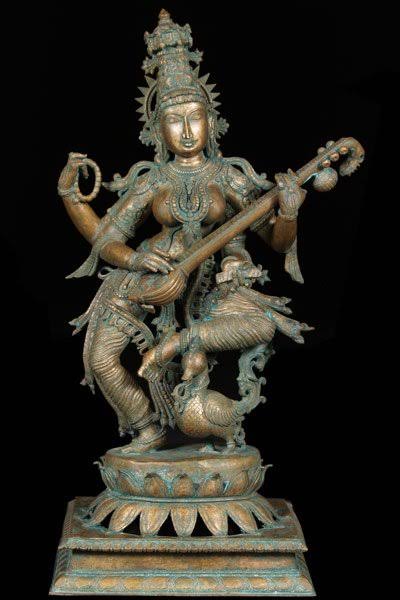
In her two left hands, she carries a palm-leaf manuscript signifying that acquiring knowledge is a must, but it is equally important to use the knowledge for humankind’s prosperity. Another hand-holding rosary symbolises attributes such as contemplation and meditation, leading devotees to ‘Dhyana’ (union with the divinity). In the upper right hand, she holds a white lotus flower, while the lower right hand typically performs the Varada mudra, the symbolic, traditional gift-giving gesture of Hinduism. Another object seen in Saraswati’s hands is the Veena (the Hindu classical music instrument), her offering of music to humanity.
Saraswati helped Brahma add order and significance to the world.
“Aavirvbhava Tatpashchanmukhataha Paramatmanaha” means one who has her origin directly from the mouth of God is Saraswati. It is believed that when Brahma (the Creator) created the matter but soon felt that it lacked form. Brahma created Saraswati (who was born from his mouth) to solve the problem as the incarnation of knowledge. Saraswati helped Brahma add order and significance to the world.
Hindu mythological sources reveal that she is the companion of “Goddess Trinity / Tridevi”, known as Saraswati, Lakshmi, and Parvati, respectively, and they succoured the Tridev – Brahma, Vishnu and Shiva in the creation, sustenance, and regeneration of the Universe.
The Creation of Saraswati
Saraswati, Goddess of knowledge, wisdom, music, arts, and spiritual consciousness, coincides with the fulfilment of the desideratum related to the origin of the celestial system in an organised and efficacious manner. Lord Brahma was clueless about structuring, organising and uniforming it. In deep contemplation, Lord Brahma, to guide, made another creation out of his mouth, a divine figure, Saraswati, the deity of embodied knowledge form.
Saraswati is the essence of creative power, energy, and source of Lord Brahma.
It was imperative to consider that the shapeless world Brahma had created wouldn’t be as holistic, refined and organised without her coming into being. That is the reason Saraswati is the essence of creative power, energy, and source of Lord Brahma, which also reasons why the deity is worshipped for the attainment of knowledge, wisdom, and spiritual consciousness.
Often, she is perceived as abstraction, as the ‘rasa’ essence of creativity and arts.
In Vak Sukta, Rigveda, she is mentioned as ‘Sangamani’ (unifier) and ‘Aham rashtiy’ (nation creator). As ‘Chikitushi, she talks about the symbiosis of humankind and nature. Goddess Saraswati is a unique goddess, a feminine force that creates an intimate bond between an artist and ‘Rasika’ (connoisseur). She exists solely in the form of sense (language, sentence, word, letter).
Saraswati is the one who controls the three Gunas; thence through the balance of qualities, ‘Sattva’ (wisdom), ‘Rajas’ (passion) and ‘Tamas’ (ignorance).
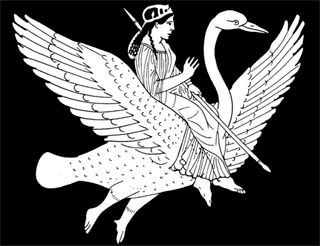
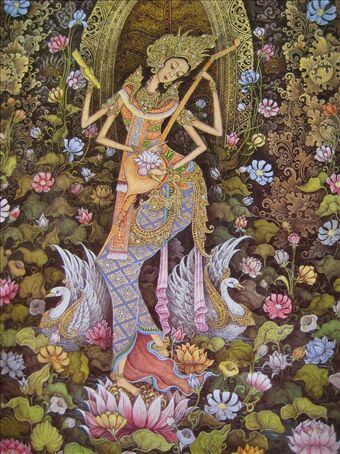
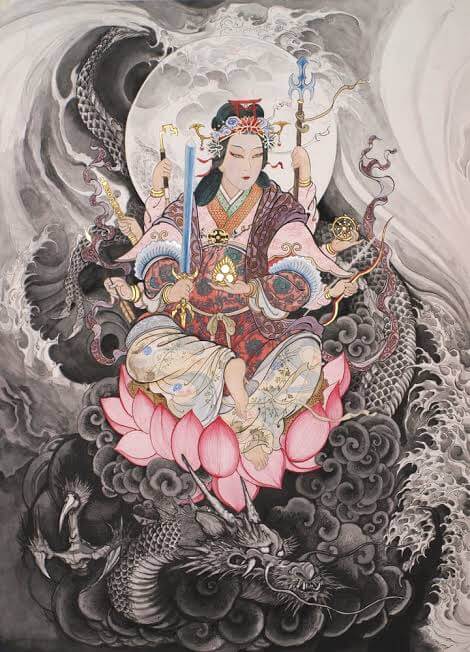
Goddess Saraswati is revered in other religions and faiths. In Burmese as Thurathadi, Chinese as Biàncáitiān. In Thai literature, Saraswati is the Goddess of speech and learning and the consort of Brahma.
Mentioned in the Lotus Sutra
Benzaiten is a Japanese Buddhist goddess who originated from the Hindu goddess Saraswati. Worship of Benzaiten arrived in Japan during the 6th-8th centuries through the Chinese translations of the Sutra of Golden Light. She is also mentioned in the Lotus Sutra and seen holding a biwa, a traditional Japanese lute, just as Saraswati holds Veena. Japan’s three most significant shrines are dedicated to the Goddess on Enoshima Island, Chikubu Island, and Itsukushima Island.
We also find traces and similarities of Saraswati in Greece and Italy.
We also find traces and similarities of Saraswati in Greece and Italy. Aphrodite, the swan riders Apollo, and Minerva share a stark resemblance to the Goddess of Learning and Wisdom.
Saraswati statues have also been found in Saudi Arabia. She is worshipped in different forms in Nepal, Bangladesh, Myanmar, Indonesia, and Tibet.
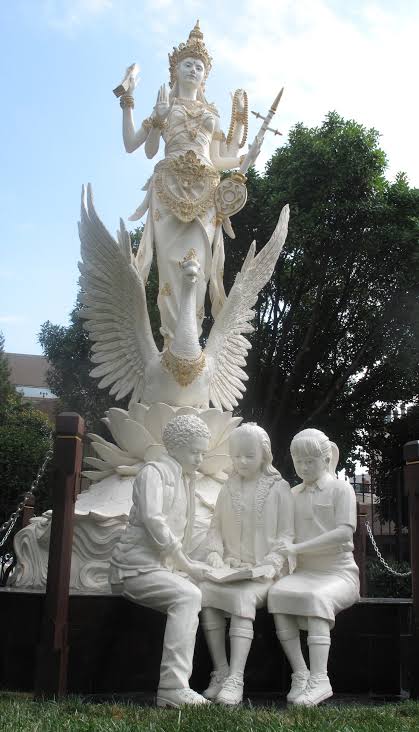
References
3. https://rudrakhsharatna.com
4. Wikimedia. commons – Picture credits
5. Feature picture Goddess Saraswati – painting by Raja Ravi Varma (1894)
Photos sourced by the author.

